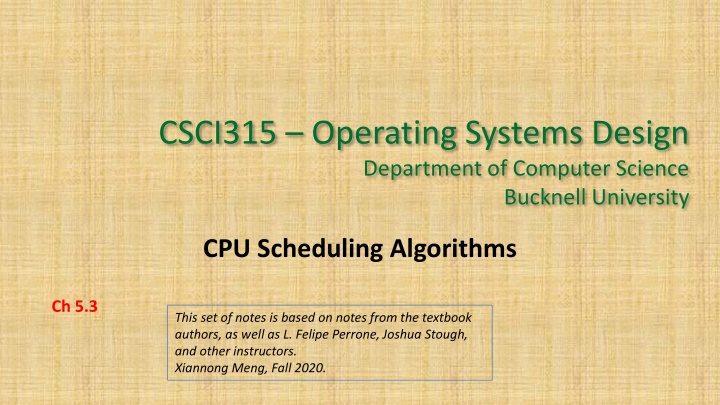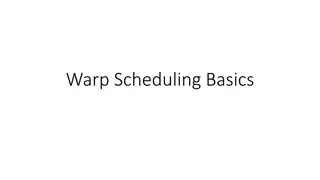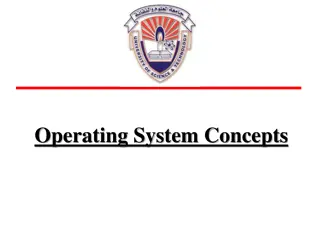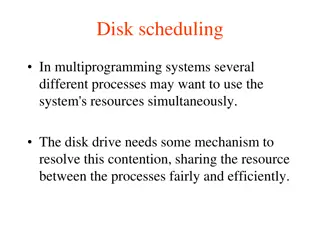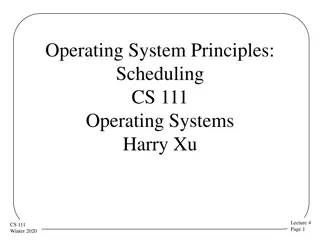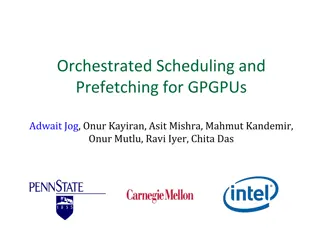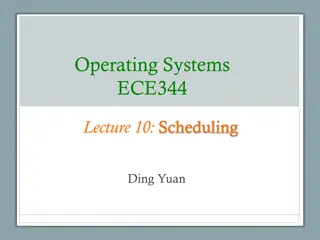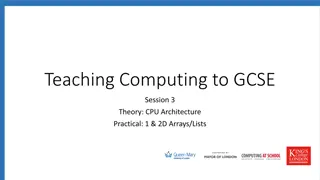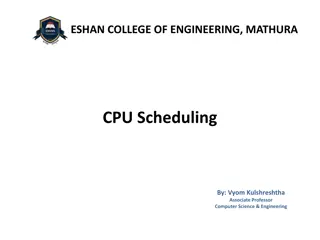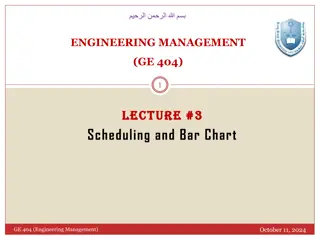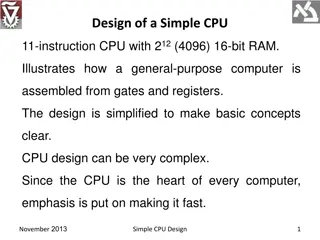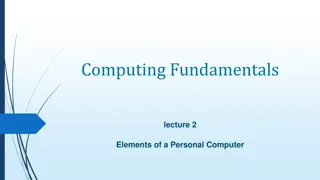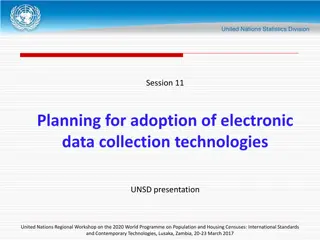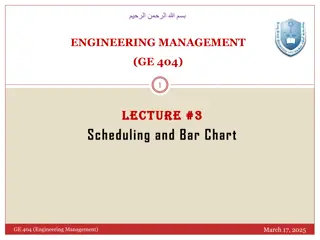CPU Scheduling Algorithms Overview
This segment explores CPU scheduling algorithms to optimize process execution for maximum performance, throughput, utilization, and minimum waiting, turn-around, and response time. It delves into First-Come, First-Served (FCFS) and Shortest-Job-First (SJF) algorithms, discussing their applications, advantages, and drawbacks. Visual aids and examples enhance the understanding of these concepts and their impact on system performance.
Download Presentation

Please find below an Image/Link to download the presentation.
The content on the website is provided AS IS for your information and personal use only. It may not be sold, licensed, or shared on other websites without obtaining consent from the author.If you encounter any issues during the download, it is possible that the publisher has removed the file from their server.
You are allowed to download the files provided on this website for personal or commercial use, subject to the condition that they are used lawfully. All files are the property of their respective owners.
The content on the website is provided AS IS for your information and personal use only. It may not be sold, licensed, or shared on other websites without obtaining consent from the author.
E N D
Presentation Transcript
CSCI315 Operating Systems Design Department of Computer Science Bucknell University CPU Scheduling Algorithms Ch 5.3 This set of notes is based on notes from the textbook authors, as well as L. Felipe Perrone, Joshua Stough, and other instructors. Xiannong Meng, Fall 2020.
CPU Scheduling Algorithms In last segment, we discussed the basic idea of CPU scheduling. We d like to arrange the execution of processes to gain maximum performance. maximum throughput, utilization minimum waiting time, turn-around time, response time In this segment, we will look at some algorithms aiming to achieve these goals.
First-Come, First-Served (FCFS) Process P1 P2 P3 Burst Time 24 3 3 Suppose that the processes arrive in the order: P1 , P2 , P3 The Gantt Chart for the schedule is: P1 P2 P3 0 24 27 30 Waiting time for P1 = 0; P2 = 24; P3 = 27 Average waiting time: (0 + 24 + 27)/3 = 17
Issues with FCFS Suppose that the processes arrive in the order P2 , P3 , P1 The Gantt chart for the schedule is: P2 P3 P1 0 3 6 30 Waiting time for P1 = 6;P2 = 0; P3 = 3 Average waiting time: (6 + 0 + 3)/3 = 3 Much better than previous case. Convoy effect: all process are stuck waiting until a long process terminates.
Shortest-Job-First (SJF) Associate with each process the length of its next CPU burst. Use these lengths to schedule the process with the shortest time. Two schemes: Non-preemptive once CPU given to a process it cannot be preempted until completing its CPU burst. Preemptive if a new process arrives with CPU burst length less than remaining time of current executing process, preempt. This scheme is know as the Shortest-Remaining-Time-First (SRTF). SJF is optimal gives minimum average waiting time for a given set of processes. Question: Is this practical? How can one determine the length of a CPU-burst?
Non-Preemptive SJF Process P1 P2 P3 P4 Arrival Time 0 2 4 5 Burst Time 7 4 1 4 SJF (non-preemptive) P1 P3 P2 P4 0 3 7 8 12 16 Average waiting time = (0 + 6 + 3 + 7)/4 = 4
Preemptive SJF Process P1 P2 P3 P4 Arrival Time 0 2 4 5 Burst Time 7 4 1 4 SJF (preemptive) P1 P2 P3 P2 P4 P1 11 16 0 2 4 5 7 Average waiting time = (9 + 1 + 0 +2)/4 = 3
Determining Length of Next CPU-Burst We can only estimate the length. This can be done by using the length of previous CPU bursts, using exponential averaging: ??+1= ? ??+ 1 ? ?? 1. ??= actual lenght of ?? CPU burst 2. ??= predicted value for the CPU burst at time ? 3. 0 ? 1 4. The effect of the value of ??
Prediction of the Length of the Next CPU-Burst The graph is shown when is 0.5
Example Given the actual (measured) CPU bursts are 6, 4, 6, 4, 13, 13, 13, and the initial estimate of is 10 as in previous slide, show the first three predictions when takes the value of 0.2 0.7 When is 0.2, estimates are 9.2, 8.16, 7.73 When is 0.7, estimates are 7.2, 4.96, 5.69 See an example computation on next slide
Example Computation ??+1= ? ??+ 1 ? ?? ti = 6, 4, 6, 4, 13, 13, 13 --- these are measured time 0 = 10, = 0.2, t0 = 6 1 = 0.2*6 + 0.8*10 = 9.2 2 = 0.2*4 + 0.8*9.2 = 8.16 3 = 0.2*6 + 0.8*8.16 = 7.73
Priority Scheduling A priority number (integer) is associated with each process. The CPU is allocated to the process with the highest priority (typically, smallest integer highest priority) Preemptive Non-preemptive SJF is a priority scheduling where priority is the predicted next CPU-burst time. Problem: Starvation low priority processes may never execute. Solution: Aging as time progresses increase the priority of the process.
Process Priority in Linux Priority scheduling is commonly used in production OSes such as Linux In Linux, the priority values range from 1 (most favorite) to 99 (least favorite) Try ps -l command on a Linux terminal Default priority of a user process is 80. We can run a CPU intensive job and use the nice command to set its priority, or renice command to change its priority. (Range of renice is 0 to 20.) https://study.com/academy/lesson/process-priorities-in-linux-definition-modification.html
To check priority levels Use Linux command chrt to check levels of priority.
default priority (80) lower the priority by 10 new priority (90) try to lower it by another 20 you can t do, minimum is 99
Round Robin (RR) Each process gets a small unit of CPU time (time quantum), usually 10-100 milliseconds. After this time has elapsed, the process is preempted and added to the end of the ready queue. If there are n processes in the ready queue and the time quantum is q, then each process gets 1/n of the CPU time in chunks of at most q time units at once. No process waits more than (n-1)q time units.
RR with Time Quantum = 20 Process Burst Time P1 P2 P3 P4 53 17 68 24 The Gantt chart is: P1 P2 P3 P4 P1 P3 P4 P1 P3 P3 0 20 37 57 77 97 117 121 134 154 162 Typically, higher average turnaround than SJF, but better response.
Time Quantum and Context Switch Time Question: What influences the choice of value for the quantum?
Turnaround Time Varies with the Time Quantum
Performance of RR Effects of the quantum length q: q large FIFO. q small q must be large with respect to context switch, otherwise overhead is too high. If q is extremely small, and we ignore the context switch cost, the result is processor sharing.
Multilevel Queue Ready queue is partitioned into separate queues: foreground (interactive) background (batch) Each queue has its own scheduling algorithm. foreground: RR background: FCFS Scheduling must be done between the queues: Fixed priority scheduling; (i.e., serve all from foreground then from background). Possibility of starvation. Time slice each queue gets a certain amount of CPU time which it can schedule amongst its processes; i.e., 80% to foreground in RR. 20% to background in FCFS .
Multilevel Feedback Queue A process can move between the various queues; aging can be implemented this way. Multilevel-feedback-queue scheduler defined by the following parameters: number of queues, scheduling algorithms for each queue, method used to determine when to upgrade a process, method used to determine when to demote a process, method used to determine which queue a process will enter when that process needs service.
Example of Multilevel Feedback Queue Three queues: Q0 time quantum 8 milliseconds (most favorite queue) Q1 time quantum 16 milliseconds Q2 FCFS (least favorite queue) Scheduling A new job enters queue Q0which is servedFCFS. When it gains CPU, job receives 8 milliseconds. If it does not finish in 8 milliseconds, job is moved to queue Q1. At Q1 job is again served FCFS and receives 16 additional milliseconds. If it still does not complete, it is preempted and moved to queue Q2.
